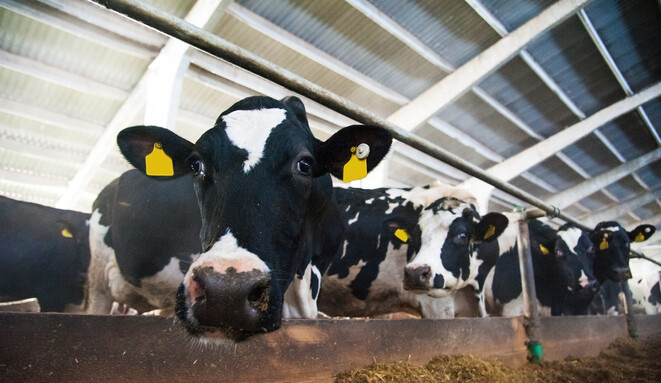As we all know, copper is an extremely important trace element that has a large effect on many different parts of the dairy cow. A cows’ copper status impacts significantly on; fertility, growth rates, bone structure, liver and red blood cell health, immune system as well as many other systems. Because of this it is really important to get their levels right to have a highly functioning modern dairy cow. Typically we think of copper status having its biggest effect on subclinical disease e.g. reduced fertility and poor growth rates. However this last year we have started to see a significant rise in cattle dying due to BOTH copper toxicity or copper deficiency.
Copper toxicity in milking cows
Milking dairy cows typically get supplemented with copper though either the water system (dosatron) or through in shed mineral feeding. This is because soil levels in New Zealand are generally too low for copper or there are other elements which interfere with copper absorption. With increased popularity of feeding palm kernel to cows (which is very high in copper) has meant a lot of farms have been over supplemented resulting in a larger number of herds get into the toxic range. Cows can live a normal life and not be affected by having toxic copper levels. However if they have a sudden stressful event e.g. calving, drying off, or sickness they can die suddenly or within 48 hours. This has been backed up by a lot of our testing where we quite commonly see cows in the toxic range but no clinical disease (reported to us anyway). However at dry off season this year, we had a farm that experienced a large number of cow deaths that was diagnosed as copper toxicity. This farm lost 15 cows during the initial outbreak and then a further 10 cows after this due to complications.
They had fed a large amount of palm kernel over the past 2 years and had no copper liver testing performed until the disease outbreak. Once tested this showed that 3/5 cows were in the toxic range. A large reason for their clinical disease outbreak is due to the perfect storm of stressful events and toxicity at the time. The cows were dried off and transitioned onto crop, so there was a large change of diet and stop of lactation. This also coincided with 3 days of terrible sleeting rain, medium distance transporting, and a significant time standing on concrete prior to transport. Unfortunately once clinical disease presents, treatment is not likely to be successful. In this case the only way to try and prevent further deaths is to limit stressors, which can be hard in certain farming situations. Hence stopping cows getting into the toxic range is the easiest way to prevent this disease.
Last season’s combined data across VetSouth from copper testing at dry off time resulted in 23.5% of farms that had 1 or more cows that were in the toxic range.
Many of these farms had multiple cows (if not all) in the toxic range too. A further 31 farms had 1 or more cow that was very close to the toxic range too. This just shows exactly how large a problem this is becoming and it is an area we would like to see some improvements in!
Copper deficiency in heifers
Just like too much copper; not enough copper can have disastrous effects. As already mentioned above deficiency can have a negative effect on production, reproduction, immune system and growth rates. Humeral fractures (foreleg) in dairy heifers are a severe complication of copper deficiency.
This problem seems to be something almost solely happening to first calving dairy heifers in early lactation although there are some reported cases of humeral fractures pre-calving and later in lactation. The first described outbreak of humeral fractures in dairy heifers was reported in 2017 in the Manawatu. In this case 6 out of 200 heifers were affected and diagnosed with “spontaneous humeral fractures”. Affected animals present with an acute, often non-weight bearing lameness of one of the front legs, most of the time with no history of trauma. The majority of fractures happen in the paddock or on the lane; very seldom while in the yard or in the milking shed.
Important to know is that affected animals do not always have to be copper deficient at the time of obtaining a humeral fracture. A period of copper deficiency at an earlier stage in life can result in the formation of fragile bone.
The bone will stay fragile for a longer period of time and will likely become more fragile due to calcium mobilisation with the onset of lactation, possibly resulting in humeral fractures. To prevent these disastrous effects of copper deficiency, more regular copper testing is needed to keep track of copper levels in young stock. The fact that copper levels can be adequate in heifers at the time they fracture their humerus illustrates that a one off copper test can put you on the wrong foot.
This highlights the importance of periodic copper testing in the first 2 years of your future dairy cow’s lives. Both of these diseases can be very easily prevented, by supplementing adequately and regular testing to make sure you are getting it right and not overdoing it. We would encourage everyone to talk to their KeyVet to have a thorough plan for supplementing and testing their milking cows and youngstock with copper. Being proactive like this can prevent stock deaths, but also improve other subclinical losses by improving fertility and growth rates.
- Theo Wieggers

